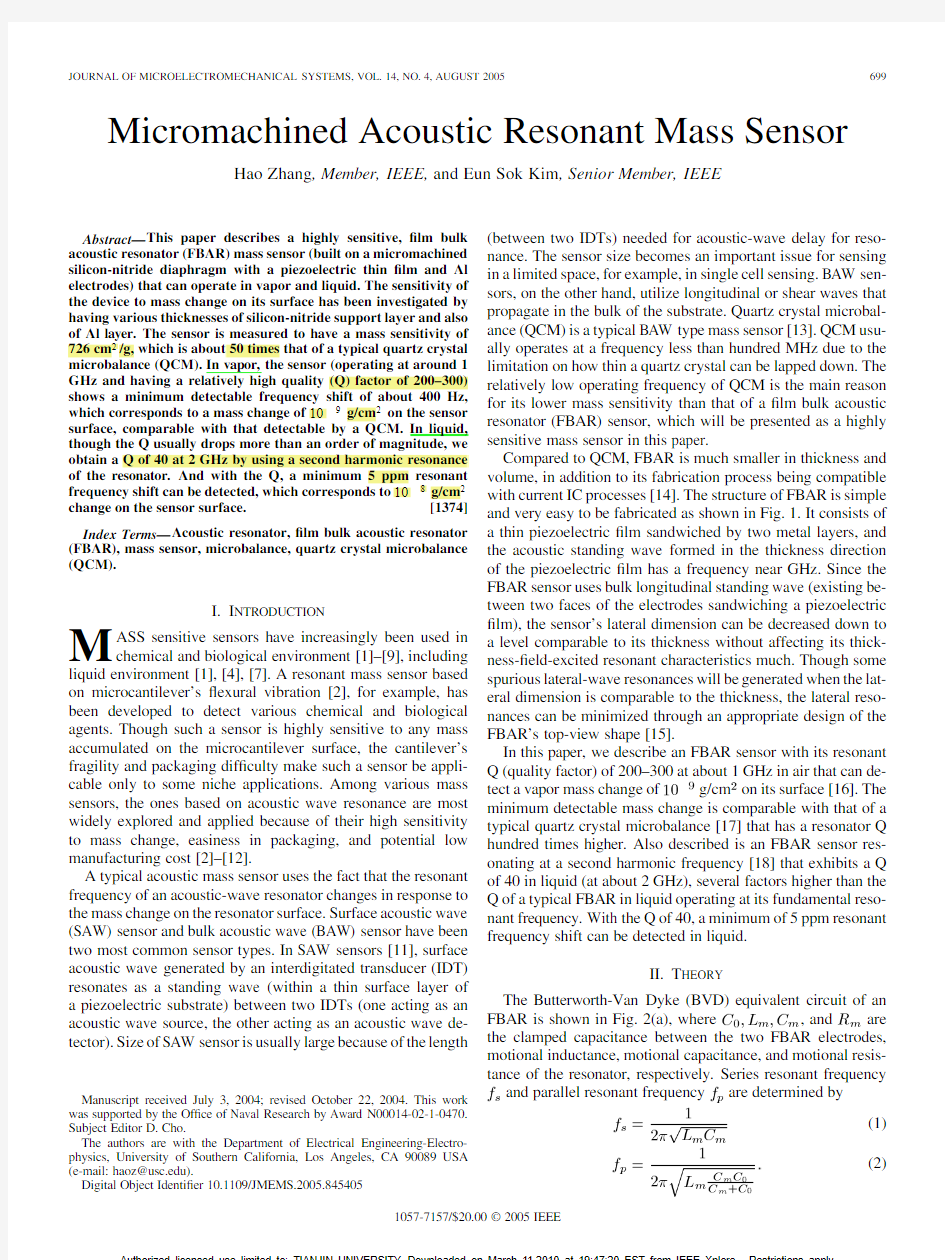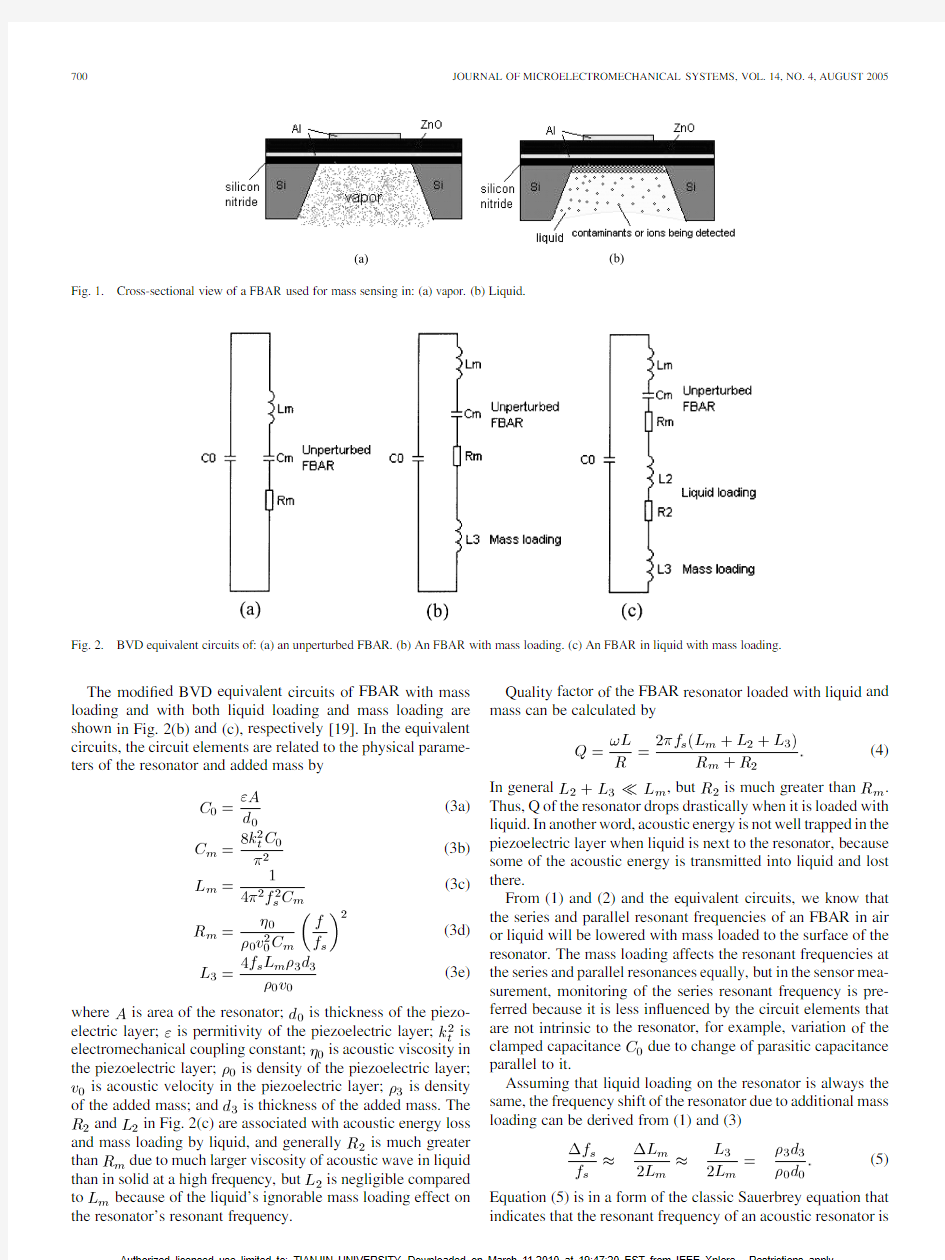Micromachined_Acoustic_Resonant_Mass_Sensor


Micromachined Acoustic Resonant Mass Sensor Hao Zhang,Member,IEEE,and Eun Sok Kim,Senior Member,IEEE
Abstract—This paper describes a highly sensitive,?lm bulk
acoustic resonator(FBAR)mass sensor(built on a micromachined
silicon-nitride diaphragm with a piezoelectric thin?lm and Al
electrodes)that can operate in vapor and liquid.The sensitivity of
the device to mass change on its surface has been investigated by
having various thicknesses of silicon-nitride support layer and also
of Al layer.The sensor is measured to have a mass sensitivity of
726cm2/g,which is about50times that of a typical quartz crystal
microbalance(QCM).In vapor,the sensor(operating at around1
GHz and having a relatively high quality(Q)factor of200–300)
shows a minimum detectable frequency shift of about400Hz,
which corresponds to a mass change of109g/cm2on the sensor
surface,comparable with that detectable by a QCM.In liquid,
though the Q usually drops more than an order of magnitude,we
obtain a Q of40at2GHz by using a second harmonic resonance
of the resonator.And with the Q,a minimum5ppm resonant
frequency shift can be detected,which corresponds to108g/cm2
change on the sensor surface.[1374]
Index Terms—Acoustic resonator,?lm bulk acoustic resonator
(FBAR),mass sensor,microbalance,quartz crystal microbalance
(QCM).
I.I NTRODUCTION
M ASS sensitive sensors have increasingly been used in
chemical and biological environment[1]–[9],including
liquid environment[1],[4],[7].A resonant mass sensor based
on microcantilever’s?exural vibration[2],for example,has
been developed to detect various chemical and biological
agents.Though such a sensor is highly sensitive to any mass
accumulated on the microcantilever surface,the cantilever’s
fragility and packaging dif?culty make such a sensor be appli-
cable only to some niche applications.Among various mass
sensors,the ones based on acoustic wave resonance are most
widely explored and applied because of their high sensitivity
to mass change,easiness in packaging,and potential low
manufacturing cost[2]–[12].
A typical acoustic mass sensor uses the fact that the resonant
frequency of an acoustic-wave resonator changes in response to
the mass change on the resonator surface.Surface acoustic wave
(SAW)sensor and bulk acoustic wave(BAW)sensor have been
two most common sensor types.In SAW sensors[11],surface
acoustic wave generated by an interdigitated transducer(IDT)
resonates as a standing wave(within a thin surface layer of
a piezoelectric substrate)between two IDTs(one acting as an
acoustic wave source,the other acting as an acoustic wave de-
tector).Size of SAW sensor is usually large because of the length
Manuscript received July3,2004;revised October22,2004.This work
was supported by the Of?ce of Naval Research by Award N00014-02-1-0470.
Subject Editor D.Cho.
The authors are with the Department of Electrical Engineering-Electro-
physics,University of Southern California,Los Angeles,CA90089USA
(e-mail:haoz@https://www.360docs.net/doc/6816700096.html,).
Digital Object Identi?er10.1109/JMEMS.2005.845405
(between two IDTs)needed for acoustic-wave delay for reso-
nance.The sensor size becomes an important issue for sensing
in a limited space,for example,in single cell sensing.BAW sen-
sors,on the other hand,utilize longitudinal or shear waves that
propagate in the bulk of the substrate.Quartz crystal microbal-
ance(QCM)is a typical BAW type mass sensor[13].QCM usu-
ally operates at a frequency less than hundred MHz due to the
limitation on how thin a quartz crystal can be lapped down.The
relatively low operating frequency of QCM is the main reason
for its lower mass sensitivity than that of a?lm bulk acoustic
resonator(FBAR)sensor,which will be presented as a highly
sensitive mass sensor in this paper.
Compared to QCM,FBAR is much smaller in thickness and
volume,in addition to its fabrication process being compatible
with current IC processes[14].The structure of FBAR is simple
and very easy to be fabricated as shown in Fig.1.It consists of
a thin piezoelectric?lm sandwiched by two metal layers,and
the acoustic standing wave formed in the thickness direction
of the piezoelectric?lm has a frequency near GHz.Since the
FBAR sensor uses bulk longitudinal standing wave(existing be-
tween two faces of the electrodes sandwiching a piezoelectric
?lm),the sensor’s lateral dimension can be decreased down to
a level comparable to its thickness without affecting its thick-
ness-?eld-excited resonant characteristics much.Though some
spurious lateral-wave resonances will be generated when the lat-
eral dimension is comparable to the thickness,the lateral reso-
nances can be minimized through an appropriate design of the
FBAR’s top-view shape[15].
In this paper,we describe an FBAR sensor with its resonant
Q(quality factor)of200–300at about1GHz in air that can de-
tect a vapor mass change of g/cm on its surface[16].The
minimum detectable mass change is comparable with that of a
typical quartz crystal microbalance[17]that has a resonator Q
hundred times higher.Also described is an FBAR sensor res-
onating at a second harmonic frequency[18]that exhibits a Q
of40in liquid(at about2GHz),several factors higher than the
Q of a typical FBAR in liquid operating at its fundamental reso-
nant frequency.With the Q of40,a minimum of5ppm resonant
frequency shift can be detected in liquid.
II.T HEORY
The Butterworth-Van Dyke(BVD)equivalent circuit of an
FBAR is shown in Fig.2(a),where,and are
the clamped capacitance between the two FBAR electrodes,
motional inductance,motional capacitance,and motional resis-
tance of the resonator,respectively.Series resonant frequency
and parallel resonant frequency are determined by
(1)
(2)
1057-7157/$20.00?2005IEEE
Fig.1.Cross-sectional view of a FBAR used for mass sensing in:(a)vapor.(b)
Liquid.
Fig.2.BVD equivalent circuits of:(a)an unperturbed FBAR.(b)An FBAR with mass loading.(c)An FBAR in liquid with mass loading.
The modi ?ed BVD equivalent circuits of FBAR with mass loading and with both liquid loading and mass loading are shown in Fig.2(b)and (c),respectively [19].In the equivalent circuits,the circuit elements are related to the physical parame-ters of the resonator and added mass
by
(3a)
(3b)
(3c)
(3d)(3e)
where is area of the
resonator;is thickness of the piezo-electric
layer;is permitivity of the piezoelectric
layer;
is electromechanical coupling
constant;is acoustic viscosity in
the piezoelectric
layer;
is density of the piezoelectric
layer;is acoustic velocity in the piezoelectric
layer;is density
of the added mass;
and
is thickness of the added mass.
The
and in Fig.2(c)are associated with acoustic energy loss
and mass loading by liquid,and
generally
is much greater
than
due to much larger viscosity of acoustic wave in liquid than in solid at a high frequency,
but
is negligible compared
to
because of the liquid ’s ignorable mass loading effect on the resonator ’s resonant frequency.
Quality factor of the FBAR resonator loaded with liquid and mass can be calculated
by
(4)
In
general ,
but is much greater
than .Thus,Q of the resonator drops drastically when it is loaded with liquid.In another word,acoustic energy is not well trapped in the piezoelectric layer when liquid is next to the resonator,because some of the acoustic energy is transmitted into liquid and lost there.
From (1)and (2)and the equivalent circuits,we know that the series and parallel resonant frequencies of an FBAR in air or liquid will be lowered with mass loaded to the surface of the resonator.The mass loading affects the resonant frequencies at the series and parallel resonances equally,but in the sensor mea-surement,monitoring of the series resonant frequency is pre-ferred because it is less in ?uenced by the circuit elements that are not intrinsic to the resonator,for example,variation of the
clamped
capacitance
due to change of parasitic capacitance parallel to it.
Assuming that liquid loading on the resonator is always the same,the frequency shift of the resonator due to additional mass loading can be derived from (1)and
(3)
(5)
Equation (5)is in a form of the classic Sauerbrey equation that indicates that the resonant frequency of an acoustic resonator is
